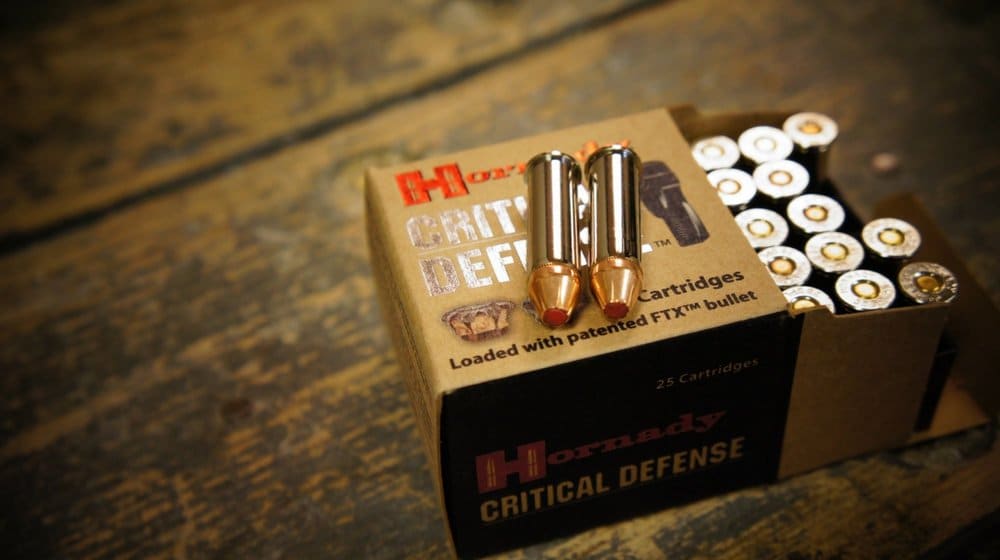Ammo
Ammo Lingo Part II: Understanding +P Ammunition
Suggestions for more information on ammunition were made following the article “Ammo Lingo: decoding what’s on the store shelf.” This is the first follow-up to those requests—regarding so-called +P ammunition. What is it and why might it make a good or bad choice for your handgun?
Published
1 year agoon

Want to know more ammo lingo? Here's a follow-up to the article “Ammo Lingo: Decoding What’s On The Store Shelf.” In this part, we'll discuss +P ammunition and find out if it's the right load for your gun.
Ammo Lingo Part II: What Does +P Mean?
Every time we go to a gun shop and purchase ammo, we often see +P in some bullet boxes. What is this ammo lingo? What does “+P” stand for? When our curiosity strikes, we look for answers. But search no more for you are about to find out what +P ammo means and why it can be a good or bad choice for your handgun.
1. How Do I Know if the Ammunition is +P?

image via ammoland
Well, it is very simple. Just look at the box's end and it will tell you the answer. In general, +P and its cousin, +P+ ammo, are designations that sometimes accompany hollow point ammunitions (HP/JHP, if you’ll reference the first Ammo Lingo article). You can see +P less often on full metal jacket ammunitions. If you’re handling individual cartridges, you'll be able to see +P or +P+ on the headstamp.
2. What is +P?

image via mygunculture
“P” stands for “pressure,” but that’s not good enough for us, yet. Here’s the scoop: Commercial ammunition manufacturers use standards of pressure set by the federally commissioned Sporting Arms and Ammunition Manufacturers’ Institute (SAAMI). This body has been around since 1926.
When the firing pin or striker hit the cartridge, the ensuing explosion inside the chamber causes pressure. This is what pushes the bullet down the barrel and onward. The pressure that comes rearward is what momentarily seals the breach in a revolver, or causes the slide of a semi-auto to cycle during the sequence of events, otherwise known as firing a shot.
Modern handguns are manufactured to function correctly within SAAMI pressure standards. In response to consumer demands or the quest for innovation, some companies have a line of +P ammunition—indicating the pressure generated by more powder in the case exceeds SAAMI standards.
Some loads contain a powder charge that exceeds even the parameters considered normal for +P rounds, and are thus called +P+. In many cases, the box ends of +P+ ammo are marked as law enforcement rounds—but there is no restriction against civilians purchasing them.
3. What is the Difference Between +P and +P+ Ammo?

image via asymammo
+P ammo achieves greater velocity than other loads of the same caliber. In most cases, you can balance this effect by using a somewhat lighter bullet. We’re talking usually within a range of 10 percent of velocity and 20 percent of bullet weight.
Winchester’s 9mm Defender line, for example, uses a 147-grain bullet in HP and a 124-grain bullet in their +P model. The Defender’s heavier bullet has a muzzle velocity rating of 954 feet per second (fps), while the +P bullet has a rating of 1,095 fps—a rather modest gain. Understand that if you’re using a shorter barrel, these velocity ratings will probably be lower. Actual measurements will vary from one gun to another.
While +P slightly exceeds the maximum envelope recommended by SAAMI for a particular caliber, +P+ ammunition goes a step further of increasing the powder charge to achieve pressures even greater than the 10 percent edge realized by +P. SAAMI guidelines are just that—guidelines, not regulations.
Felt recoil increases with +P ammo. That’s less comfortable and is a slight disadvantage in being able to deliver accurate follow-up shots on the range.
4. Can My Handgun Shoot +P/+P+?

image via bmcgilvray/smith-wessonforum
+P ammunition generates more heat and potential wear and tear on a handgun. Most modern semi-autos will fire it, though reliability in feeding can vary. Check your owner’s manual to see if there is any recommendation regarding this ammunition. If you use +P exclusively and practice often, expect to replace parts sooner than normal.
“Reliability in feeding can vary” is another way of saying that +P ammo may cause jams. Semi-auto handguns are manufactured so the slide will travel rearward, extract and eject the empty case, and load a new cartridge, in accordance with pressures generated by standard powder loads. The +P factor may move the slide too fast to do all those jobs reliably.
Modern revolvers, such as the Ruger LCR .38 Special in the photo, often have markings of “+P” to indicate it’s safe to use this ammunition in them.
There’ll be more noise, muzzle flash, and recoil anytime you use +P. Don’t hesitate to contact your revolver’s manufacturer to get their recommendation if your gun doesn't have a stamp and the owner’s manual is no help. If you have a historic handgun or the manufacturer can’t give a straight answer, the added pressure may be risky for both you and the firearm.
5. Is +P/+P+ a Good Choice of Ammunition?
Mastering the reloading basics, the perfect guide. Learn the step by step approach by reading the blog. #reloadfacts https://t.co/xXV5liTqTV
— Gun Carrier (@GunCarrierUSA) August 7, 2017
Is the increase in velocity, which should improve penetration and the ability to be more accurate at greater distances, worth the trade off in the form of a lighter bullet that possibly has less expansion activity on a flesh target? It’s a decision only you and your gun can make.
Be sure to test any ammunition you’re going to carry in your firearm. Fire multiple-shot sequences to be sure that feeding performance for your semi-auto, or cycling and reloading of your revolver are reliable, especially when the gun is hot from firing it repeatedly.
+P/+P+ ammunition is usually more expensive than FMJ priced in the same ballpark as other HP loads. It can be a worthy choice if you’ve tested it in your firearm for accuracy and reliability.
Looking for the best self-defense ammo? Watch this video from Lucky Gunner Ammo and find out the factors you need to consider when choosing the right self-defense ammo for your handgun!
Overpressurized ammunition or +P are bullets that have more pressure than the standard rounds of its caliber. It packs more power for greater penetration and has faster muzzle velocity. However, these loads can only be used for firearms specifically designed to handle high-pressure levels. So before using this type of ammo, you need to read your gun manual first. Check if it's rated for +P and if not, don't attempt to use it as your gun might blow up.
Sound off Gun Carriers! Do you know other ammo lingos? Let us know in the comments below. Then, make sure you subscribe to the Gun Carrier YouTube channel.
UP NEXT: What You Need To Know About Buying Ammo Online
Follow us on Facebook, Instagram, Twitter, Tumblr, and Pinterest!
Featured Image Via gunnuts

Staccato P Review | Staccato P 1000 Round – The Most Accurate Duty Pistol

Sawed Off Shotgun | Everything You Need To Know

CZ 75 SP01 Tactical Gun Review | Gun Carrier

PODCAST: Gun Law Changes All Across America Right Now

PODCAST: How to Win Olympic Gold

PODCAST: 50 Important Ideas For Self-Defense, Self-Reliance, and Personal Safety



Pingback: Weekend Knowledge Dump- September 15, 2017 | Active Response Training